2.1 Newton's Laws of Motion: First and Second Law
7 min read•june 18, 2024
Daniella Garcia-Loos
Gerardo Rafael Bote
AP Physics C: Mechanics ⚙️
68 resourcesSee Units
Overview
Now that you understand motion, you ask yourself: what causes these things to move in the first place? A certain guy named Isaac Newton developed many theorems and laws that help explain how certain things move and stop. In this unit especially, you will need to learn how his three laws describe the relationship between an object's motion and the forces it interacts with. Plus, in this unit, you will get to know about how circular motion plays a role in movement. You will need a good understanding of this unit to successfully learn other units in this course.
Big Idea
- Force Interactions: Forces characterize interactions between objects or systems.
- After you've stopped stirring a cup of coffee or tea, why does the swirling motion continue?
- If you apply the same amount of "push" to a car as you would to a shopping cart, why doesn't the car move at all?
- Why will the sun set tomorrow in nearly the same place that it set today?
- Why must you push backward to make a skateboard move forward?
Exam Impact
Unit 2 will cover approximately 17%-23% of the exam and should take around 24, 45-minute class periods to cover. The AP Classroom personal progress check has 25 multiple choice questions and 1 free response question for you to practice on.
Newton's Laws of Motion: First and Second Law 🥏
For the first topic in this unit, you will need to focus on Newton's first 2 laws. The laws state:
Newton's First Law of Motion: A body at rest will remain at rest unless an outside force acts on it, and a body in motion at a constant velocity will remain in motion in a straight line unless acted upon by a net external force.
Newton's Second Law of Motion: If an unbalanced force acts on a body, that body will experience acceleration (or deceleration).

Newton's First Law is all about inertia, which is the tendency of an object to resist acceleration. Newton's Second Law is all about finding the net force, which is where Free Body Diagrams come in handy.
Now that you know the two laws, you need to properly apply them. Be careful! Topic 2.1 covers a TON of concepts, so be sure to practice with the questions below to fully understand Newton's laws.
Always, always, always consider direction and angles!
For this unit, it is very helpful to use free-body diagrams or FBDs. Each FBD will help you determine what forces are active and interacting with the object within a certain time frame. Here is an example of what a simple FBD could look like:
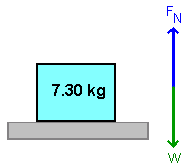
Image from Alberta Learning
For the FBD on the right, you can see that there are 2 forces acting on the box sitting at rest: gravitational force (weight)and normal force.
Now assume that the box has a mass of m = 7.3 kg. How can you figure out how much each force is exerting on the box? All of you have to do is apply the Second Law of Motion: ΣF = ma. ΣF is read as "the sum of all forces".
TIP: Be careful in determining how ΣF is set up! You should consider that forces are also vectors, meaning that direction is important (like in kinematics). When writing out your work for FBDs, separate the forces into their horizontal and vertical components.
For the box example, we would set up ΣF as so:
ΣF_y = F_n - F_g
Then, figure out the box's acceleration. For the box, since it as at rest and there is no vertical acceleration, then we can claim that a = 0 m/s^2. Then set up the equation:
F_n - F_g = ma = (7.3)(0)
F_n - F_g = 0
F_n = F_g = mg = (7.3)(10) = 73 N
The normal force exerts an upward force of 73 N (or 73 kg•m/s^2) while the gravitational force exerts a downward force of 73 N, putting the box at equilibrium.
Friction Force
Here are equations that you should be aware of:
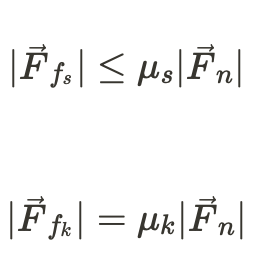
The equations above deal with friction, a force that opposes the motion of one surface past another. Friction is exerted by the interacting projections on the surface of the object and the surface interacting with the object.
Friction is always:
- Parallel to the surface
- Opposing the direction of motion
- Independent from the applied force
There are two types of friction:
Static friction (friction force exerted on a stationary object), is when two surfaces do not slide relative to one another.

apply to static friction. Pay special attention to the less than/equal to sign because the force of friction will change to fit the scenario until it reaches its maximum. The equation for the maximum is especially useful for scenarios like “the maximum angle of incline at which the block will not slip".
Kinetic friction (friction force exerted on a moving object), is when two surfaces do slide relative to one another.
Only

applies in kinetic friction.
Here are some key differences between static and kinetic friction:
- Friction is a force that acts between two surfaces that are in contact and are trying to slide past each other.
- Static friction is the force that acts between two surfaces that are not moving relative to each other. It is the force that must be overcome in order to start an object sliding.
- Kinetic friction is the force that acts between two surfaces that are sliding past each other. It is the force that slows down an object that is sliding.
- Static friction is generally greater than kinetic friction. This means that it takes more force to start an object sliding than it does to keep it sliding.
- The magnitude of the frictional force (both static and kinetic) depends on the roughness of the surfaces and the normal force pressing the surfaces together.
- Static friction has a maximum value, which is the product of the coefficient of static friction and the normal force. Once the applied force exceeds this value, the object will start to slide.
- Kinetic friction has a constant value, which is the product of the coefficient of kinetic friction and the normal force. This means that the frictional force does not change as the object slides.
You will also notice that weird μ(pronounced: "mew") in both equations. That μ represents the coefficient of friction of a surface. The coefficient is always constant throughout a given surface.
Additionally, it should be noted that generally μ_s > \μ_k.
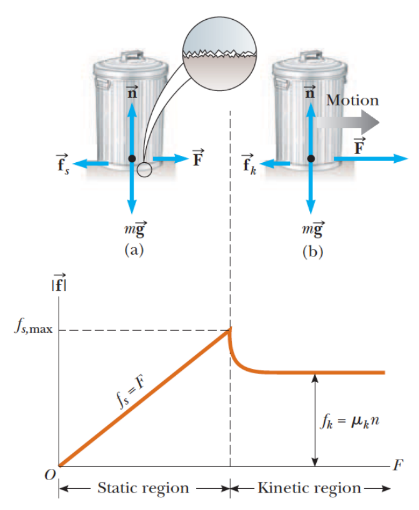
Image from Dan Levine
TIP: It is important to note that the static force increase as the exerted force increases until the object breaks free from the surface. (as shown on the graph above)
*I'm still confused... what can I do to make sure that I understand Newton's First & Second Laws?
I understand where you're coming from. When I first learned this unit, I was also confused. But, here is one keyword you should take note of: PRACTICE. Look at FBDs, look at angles, and make sure everything is in its x- and y-components!
You can also use this PhET simulation to understand how forces work in one dimension. You may have to adjust the simulation's dimensions to fit your screen. The application might also take a while to load due to your device's specifications.
Simulation from PhET
Practice Questions:

Image from Dan Levine
a) Draw a free body diagram illustrating all forces acting on the box. b) Draw a free body diagram illustrating the net force acting on the box. c) Determine the friction force exerted on the box. d) Determine the coefficient of static friction.
Answer
a) Your FBD should look something similar to this (remember to label!):
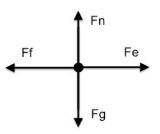
Image from Dan Levine
b) Since the wooden box remains stationary, your FBD should look something similar to this (remember to label!):

Image from Dan Levine
c) Since the wooden box is at rest, ΣF_x = 0
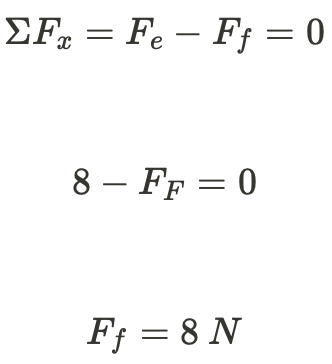
d) Since the wooden box is at rest, ΣF_y = 0.
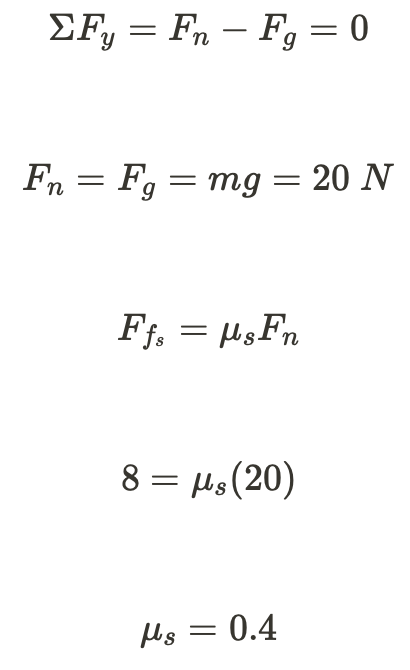
Do coefficients of friction have a unit? Nope! They are unit-less and only represent the ratio of frictional force to normal force.

Image from Dan Levine
Answer
Use calculus here! Given that you have the position formulas, take the derivative of each equation twice to get each acceleration formula (since we are dealing with net force):
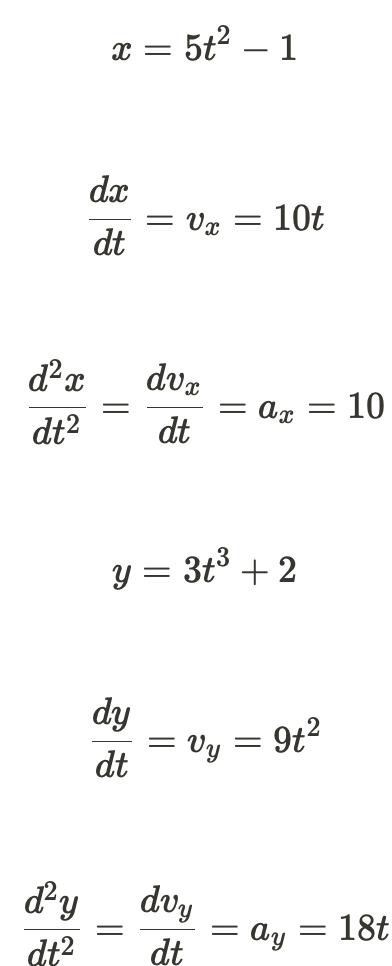
Next, determine the x-direction acceleration and y-direction acceleration of the object: a_x(2) = 10 m/s^2 and a_y(2) = 18(2) = 36 m/s^2. Then, use the Pythagorean Theorem to determine the resultant acceleration: a = sqrt{10^2+36^2} = 37.363 space m/s^2. Finally, apply Newton's 2nd law to find the magnitude of the net force:
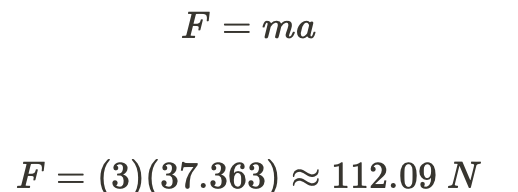
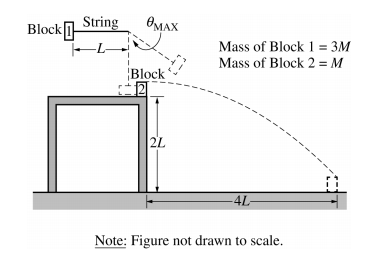
Image from collegeboard.org

Image from collegeboard.org
Answer

Image from collegeboard.org
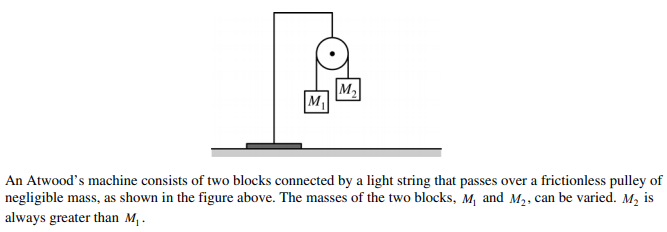
Image from collegeboard.org
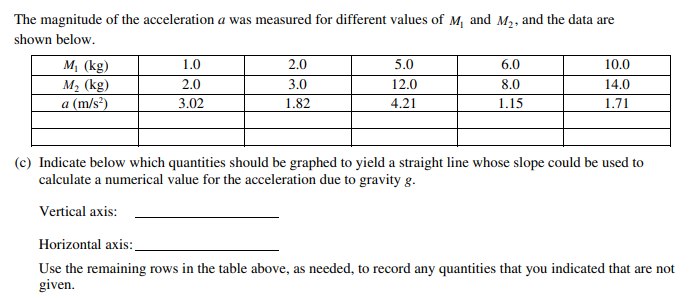
Image from collegeboard.org
Answer

Side note: When creating a graph given the values of acceleration and two blocks of mass, it is usually created to make a graph that would demonstrate a slope of g, the acceleration due to gravity.
Two teams of nine members each engage in a tug of war. Each of the first team's members has an average mass of 68 kg and exerts an average force of 1350 N horizontally. Each of the second team's members has an average mass of 73 kg and exerts an average force of 1365 N horizontally. (Taken from Lumen Learning)
a) What is the magnitude of the acceleration of the two teams? b) What is the tension in the section of rope between the teams?
Answer
a) 0.11 m/s^2
First, start off by drawing your Free Body Diagrams. I would create a FBD for each team and include: Applied Force, Force of Gravity, Normal Force, and Tension.
Then, set up two equations of the forces in the x direction based your diagrams. Ft is the force of tension, Fa is the applied force, m is mass, and a is acceleration of the system.
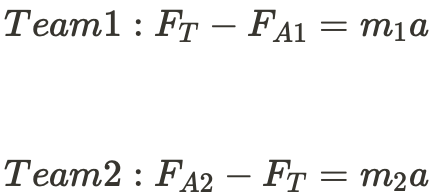
Then you can insert the information given to you by the problem.
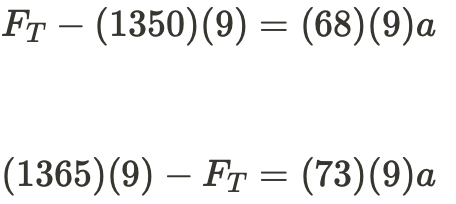
Since we have two equations and two unknowns, we can use substitution to find acceleration.
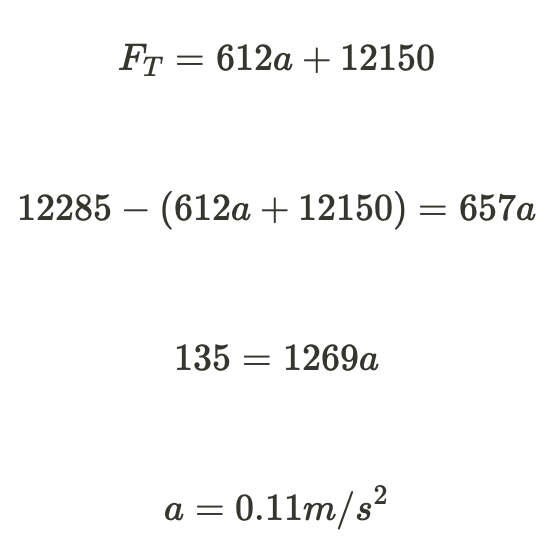
b) 1.2 * 10^4 N
You can use all the work you set up for part a and substitute the acceleration into one of the equations for a team, since the tension force for both teams should be equal.
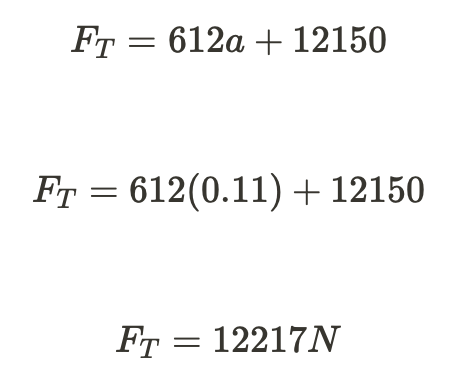
Browse Study Guides By Unit
🚗Unit 1 – Kinematics
🚀Unit 2 – Newton’s Laws of Motion
🎢Unit 3 – Work, Energy, & Power
🎳Unit 4 – Systems of Particles & Linear Momentum
🚲Unit 5 – Rotation
🌊Unit 6 – Oscillations
🪐Unit 7 – Gravitation
📚Study Tools

Fiveable
Resources
© 2025 Fiveable Inc. All rights reserved.